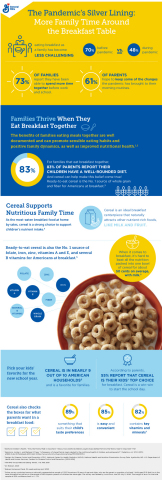Survey Reveals Silver Lining of Pandemic: More Family Time Around the Breakfast Table
Survey Reveals Silver Lining of Pandemic: More Family Time Around the Breakfast Table
For families that eat breakfast together, 83% of parents report their kids have a well-rounded diet – a motivating halo for keeping up the trend in a new school year.
MINNEAPOLIS--(BUSINESS WIRE)--The COVID-19 pandemic has disrupted morning routines around the country for 80% of U.S. parents, but the silver lining may be Americans’ new-found time around the breakfast table with their children.
In a new survey commissioned by General Mills Big G cereals, 70% of parents cite the biggest morning challenge is to sit down and have breakfast as a family. However, with the pandemic shaking up usual morning routines, 73% of families with school-aged children now report they have been able to spend more time together as a family before starting their work or school day. With the change of pace, 53% of parents are using breakfast time to discuss what’s going on in the world. Dropping 22-percentage points, the survey indicates eating breakfast as a family has become less challenging (70% before pandemic vs. 48% during pandemic).
“Even in a challenging time, families are taking heart in the extra moments they have to share with their kids,” says Amy Cohn, RD, senior manager of nutrition and external affairs for General Mills cereal division. “Cereal is a common denominator. While we know the school year may look different this fall, parents and kids can count on cereal to keep bringing them around the table together and helping to fuel their day.”
Families thrive when they eat breakfast together.
The benefits of families eating meals together—whether homemade or a bowl of a shared favorite cereal—are well documented and can promote sensible eating habits and positive family dynamics, as well as improved nutritional health.1-2
This survey showed that families who eat breakfast together are 54% more likely to say their children have a well-rounded diet.
But cereal’s nutritional benefits aren’t top of mind.
As the most-eaten breakfast food at home by sales, cereal is a strong choice to support children’s nutrient intake.3 Ready-to-eat cereal is the No. 1 source of folate, iron, zinc, vitamins A and E, and several B vitamins for Americans at breakfast, according to national health and nutrition consumption data.4
However, cereal’s package of nutrition isn’t top of mind for some. Ready-to-eat cereal is the No. 1 source for both fiber and whole grain at breakfast 4. Yet, parents identified fiber and whole grain as nutrients their kids were least likely to get enough of in their diets.
“When it comes to breakfast, it’s hard to beat all the nutrition packed into one bowl of cereal for about 50 cents on average, with milk,” says Cohn. “Cereal is an ideal breakfast centerpiece that naturally attracts other nutrient-rich foods, like milk and fruit. A cereal breakfast with milk and a banana delivers really good nutrition, while also being accessible and affordable to families nationwide.”
Pick your kids’ favorite for the new school year.
Cereal is a win-win to start the school day. Cereal is in nearly nine out of 10 American households5 and is a favorite for families. According to parents surveyed, 55% report that cereal is their kids’ top choice for breakfast. And more families are eating cereal during this time. In General Mills fourth quarter, the company saw a 26% growth in its U.S. cereal business.
Cereal also checks the boxes for what parents want in a breakfast food: something that suits their child’s taste preferences (89%), is easy and convenient (85%), and contains key vitamin and minerals (82%).
For the 61% of parents who hope to keep some of the changes the pandemic has brought to their morning routines, cereal could be the ticket to family time and nutritional health.
“A meal together can truly be this simple. Because of cereal’s family appeal, it can support good nutrition for everyone, from kids to parents and grandparents,” adds Cohn.
About General Mills
General Mills is a leading global food company whose purpose is to make food the world loves. Its brands include Cheerios, Annie's, Yoplait, Nature Valley, Häagen-Dazs, Betty Crocker, Pillsbury, Old El Paso, Wanchai Ferry, Yoki, BLUE and more. Headquartered in Minneapolis, Minnesota, USA, General Mills generated fiscal 2020 net sales of U.S. $17.6 billion. In addition, General Mills’ share of non-consolidated joint venture net sales totaled U.S. $1.0 billion.
Survey:
This survey was conducted online among a nationally representative sample of 1,003 Americans 18 years of age and older, who are the parent or guardian of at least 1 child aged 5-18 that live in the same household as well as an oversample of 250 Hispanic parents of children the same ages. The survey was fielded by Lucid from June 23-July 5, 2020. The margin of error for the total sample at 95% confidence level is +/- 3%.
References:
- Stanford Children’s Health. “Why the Family Meal Is Important.” (https://www.stanfordchildrens.org/en/topic/default?id=why-the-family-meal-is-important-1-701)
- Hammons, Amber J, and Barbara H Fiese. “Is frequency of shared family meals related to the nutritional health of children and adolescents?.” Pediatrics vol. 127,6 (2011): e1565-74. doi:10.1542/peds.2010-1440 (https://www.ncbi.nlm.nih.gov/pmc/articles/PMC3387875/)
- The NPD Group National Eating Trends, 1 YE Feb 2019
- Centers for Disease Control and Prevention (CDC). National Center for Health Statistics (NCHS). National Health and Nutrition Examination Survey Data. Hyattsville, MD: U.S. Department of Health and Human Services, Centers for Disease Control and Prevention, [2015-2016]
- Nielsen Homescan Panel, 52 weeks ending April 2020
Contacts
Mike Siemienas, 763-764-6364

